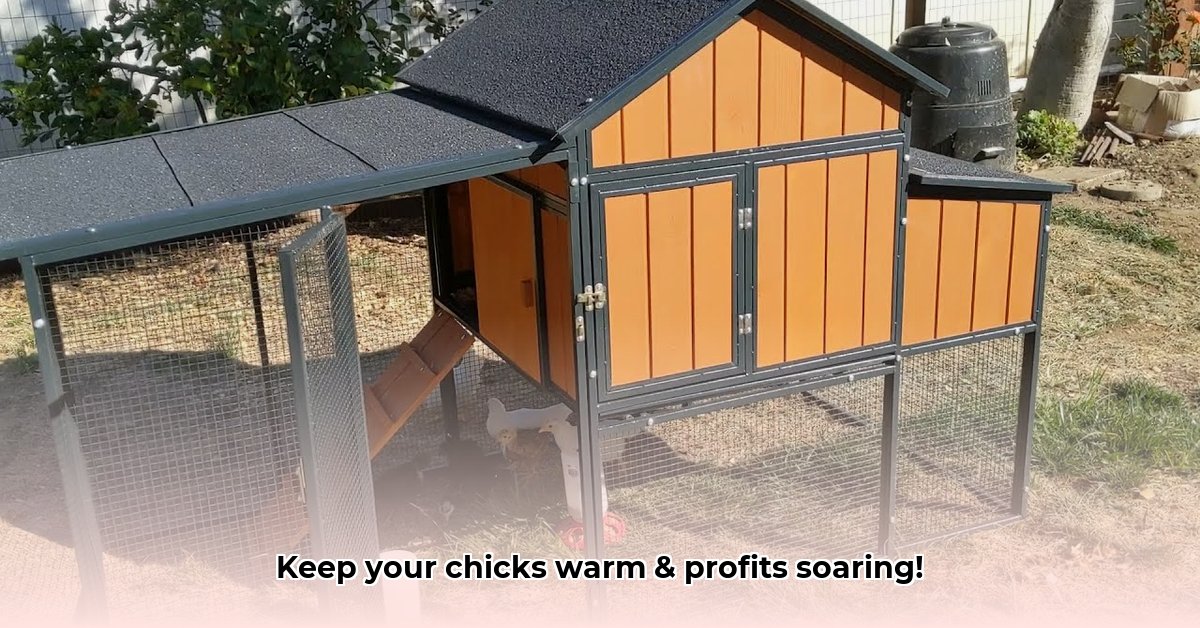
Keeping Your Flock Cozy and Your Profits Up
Maintaining optimal chicken coop temperatures during winter is crucial for maximizing egg production and minimizing health issues. A warm coop translates directly to higher profits—fewer vet bills, more eggs, and happier hens. However, selecting the right coop heater can be challenging. This guide focuses on practical steps to help you choose and safely install a Tractor Supply heater suitable for your needs.
For more heater options, check out these propane heaters.
Assessing Your Heating Needs: A Farmer's Checklist
Before heading to Tractor Supply, thoroughly assess your coop and climate. Think of this like sizing a home heating system—a small space requires less heating than a large one.
Flock Size: The number of chickens influences your heating needs. Larger flocks generate more body heat but still require supplemental warmth, especially during extreme cold.
Coop Dimensions: Measure your coop's length, width, and height. Larger coops require more powerful heaters to maintain consistent temperatures. Accurate measurements are crucial for selecting an appropriately sized heater.
Local Climate: Consider average winter temperatures and the frequency of sub-freezing weather. Colder climates necessitate higher-wattage heaters. Check historical weather data for your region.
Coop Insulation: Well-insulated coops retain heat better, reducing heating requirements. Improving insulation can significantly lower heating costs.
Actionable Step: Create a detailed inventory of your coop's dimensions, insulation, and the number of chickens. Record average winter temperatures for your area.
Choosing Your Tractor Supply Heater: Prioritizing Safety and Efficiency
Tractor Supply offers a variety of chicken coop heaters. While detailed online specifications may be limited, visiting your local store allows for direct examination and questions.
Key Selection Criteria:
Wattage (Power): Higher wattage provides more heat but increases energy consumption. Select a wattage appropriate to your coop's size, insulation, and climate. Consider future expansion when choosing wattage.
Heating Area: Ensure the heater's specified heating area adequately covers your coop's dimensions. Avoid undersized heaters that struggle to maintain consistent warmth.
Safety Features: Prioritize heaters with overheat protection and tip-over shutoff switches. These features are vital for fire prevention.
Energy Efficiency (Cost): Although initial costs vary, energy-efficient heaters can save money over time. Consider the total cost of ownership (purchase price + energy consumption).
Actionable Step: Visit your local Tractor Supply store to examine available heaters and compare specs. Prioritize safety features.
Here's a simplified comparison table:
| Feature | Low Wattage Heater | Medium Wattage Heater | High Wattage Heater |
|---|---|---|---|
| Best For | Small coops, mild climates, well-insulated coops | Medium-sized coops, moderate climates | Large coops, cold climates, poorly insulated coops |
| Wattage | <500 watts | 500-1500 watts | >1500 watts |
Safe Heater Installation: A Step-by-Step Guide
Proper heater installation is critical for safety and to ensure efficient heating. Improper installation can lead to fire hazards or injuries.
Step 1: Safe Placement: Position the heater away from flammable materials (wood shavings, hay) by at least two feet. Ensure adequate clearance.
Step 2: Electrical Safety: Verify your wiring complies with electrical codes and can handle the heater's wattage. Consult a qualified electrician if needed. Electrical safety is paramount.
Step 3: Regular Inspection: Regularly inspect the heater for damage, loose wires, or unusual sounds/smells. Early detection prevents major problems.
Step 4: Ventilation: Ensure adequate coop ventilation to prevent moisture and gas buildup. Proper ventilation improves air quality and heater efficiency.
Actionable Step: Carefully follow the manufacturer's installation instructions. If unsure, consult a qualified professional.
Long-Term Investment in Your Flock's Well-being
Investing in a reliable heater is an investment in your chickens' health and your farm's profitability. Heaters contribute to higher egg production and reduce veterinary expenses.
However, ongoing research is needed to optimize sustainable heating solutions. Consult your local agricultural extension office for region-specific recommendations and energy-efficient options. They can provide valuable data not always available online.
Actionable Step: Contact your local agricultural extension office for region-specific recommendations and energy efficiency programs.
Comparing Energy Efficiency: A Practical Approach
While direct comparison of energy efficiency among heaters is hampered by limited data, several factors directly impact energy consumption.
Understanding Energy Usage
Wattage directly indicates energy consumption. However, other factors influence overall efficiency:
Heater Type: Different heater types (infrared, panel) have varying heat distribution and efficiency.
Coop Insulation: Well-insulated coops retain heat, reducing energy demands.
Climate: Harsh winters require more energy than mild ones.
Actionable Step: Track electricity usage to gather data for future heater comparisons.
Practical Steps for Energy-Efficient Heating
Minimize heat loss: Improve coop insulation to reduce energy needs.
Optimize temperature control: Use a thermostat to maintain the ideal temperature range for your chickens.
Consider passive heating: Improve coop design for natural heat retention.
Prioritize safety: Choose heaters with safety features to prevent accidents and ensure longevity.
Monitor energy use: Track electricity consumption to assess heater efficiency over time.
The Need for Further Research
Comprehensive energy-efficiency data for chicken coop heaters is limited. More research is needed to provide farmers with clear, comparative information. Until then, a holistic approach combining efficient heaters with well-insulated coops remains the most effective strategy.